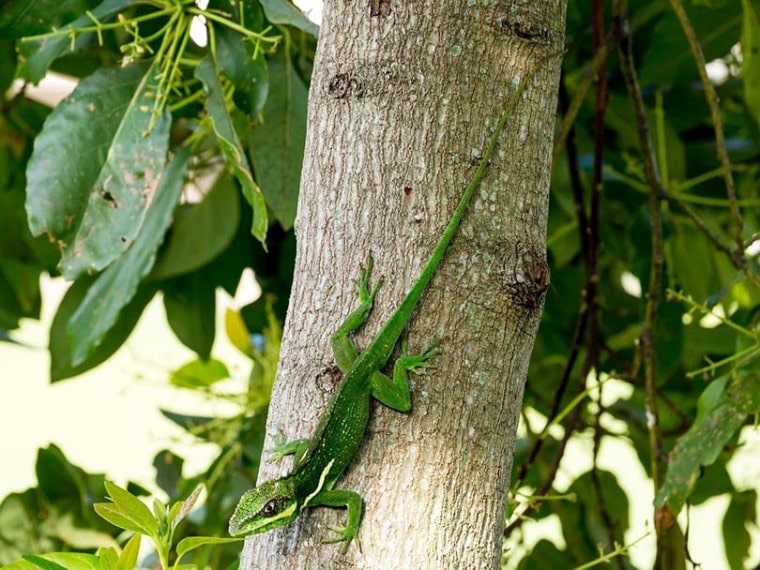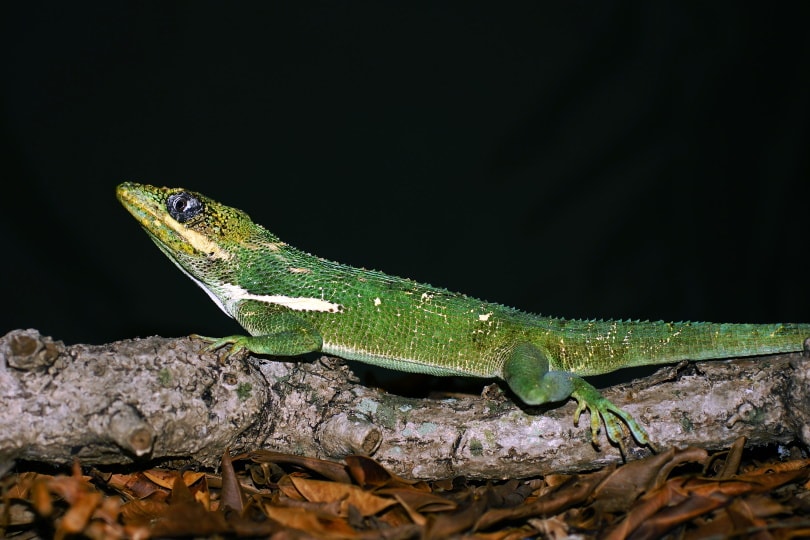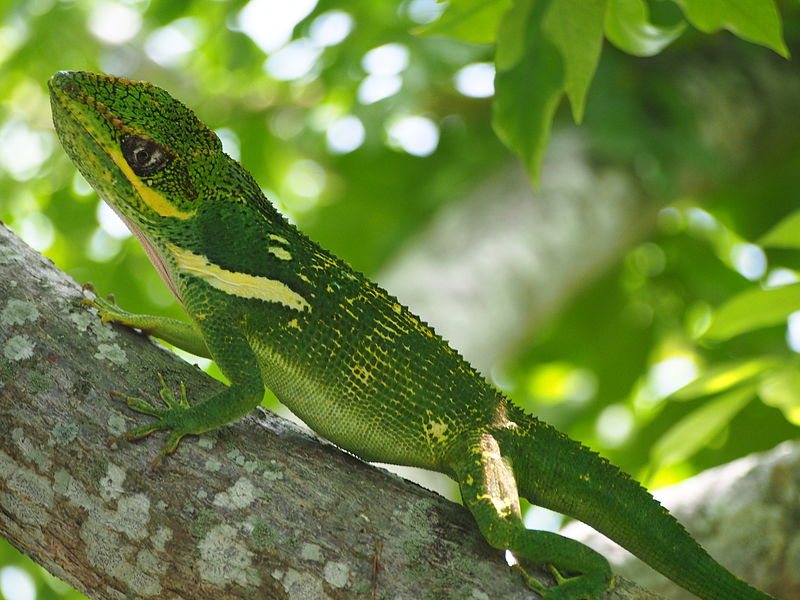
Knight Anoles are commonly mistaken for iguanas. Although they are related to iguanas, they are a species of lizard that deserve their own recognition. These are not popular pets in the United States, although they can be found living in the wild in Florida and are typically kept as popular show animals by zoos, pet shops, and other organizations.
These lizards are beautiful and exotic and can live for up to 10 years in captivity. Are you eager to learn more about this unique animal? Read on!

Quick Facts About the Knight Anole

| Species Name: | Anolis equestris |
| Common Name: | Knight Anole, Cuban Knight Anole |
| Care Level: | Medium |
| Lifespan: | 8 – 10 years |
| Adult Size: | 15 – 20 inches long |
| Diet: | Insects, snails, fruits |
| Minimum Tank Size: | 2 ft. x 2 ft. x 4 ft. |
| Temperature & Humidity: | 75-90 degrees Fahrenheit, tropical/high humidity |
Do Knight Anoles Make Good Pets?
The Knight Anole is not commonly kept as a pet in the United States or in many other places, for that matter. However, some people have acquired these creatures as pets and have had great success in raising them. If you are interested in owning a Knight Anole, you may have to search out of your local area and work with exotic pet breeders to find one.
It never hurts to check with pet shops before taking any extra steps, though, as you never know what they have to offer at any given time. It is important to note that the reason these animals are not popular pets is that they are not social, and they can be aggressive with humans trying to interact or handle them.
However, if you are looking for a pet to watch and enjoy from afar, with little personal hand interaction required, this is a pet worth considering. It is important to make sure that a Knight Anole has plenty of habitat space to utilize, as they will spend little time outside of it.

Appearance
Knight Anoles do not come in a variety of colors or patterns. They look like large lizards or small iguanas and are bright green all over. They typically display light yellow stripe markings on the sides of their shoulders and heads. However, these features can change depending on the situation and environment, as Knight Anoles can slightly change color to camouflage into their surroundings at any given time.

How to Take Care of a Knight Anole
If you do plan to get a Knight Anole as a pet, you should learn about their habitat, food, and general care needs first. This will help ensure that you are capable and willing to handle the commitment that is required as a Knight Anole owner.

Tank
Knight Anoles in captivity should live in enclosed habitats for their health and safety. If left to roam free throughout the house, they could easily become injured or end up outdoors, where they may not ever be found again. They could also freeze or end up starving, depending on where they end up.
Therefore, it is important to invest in a wire or glass habitat of at least 2 ft. x 2 ft. x 4 ft. in size. The cage should be completely enclosed yet have multiple doors and a removable top for easy cleaning and safe handling when necessary.
Lighting
Knight Anoles require warm, humid environments to thrive in, so they require the help of halogen heat lamps and a digital thermometer. The lamps should keep temperatures between 85 and 95 degrees Fahrenheit during daytime hours. At night, the lights can be turned off, as long as temperatures stay between 65 and 80 degrees Fahrenheit.
Humidity
These animals enjoy humid weather and thrive when humidity reaches between 75% and 80%. To keep a Knight Anole’s habitat nice and humid, spray the space with water once or twice a day. Use a hygrometer to determine humidity levels, and experiment with how much water spritzing needs to be done throughout the day to maintain proper humidity levels.

Substrate
Every Knight Anole habitat should be covered with substrate, which is simply a mixture of absorbent material that lays over the flooring. Substrate soaks up water that is leaked during bathing and drinking, extra humidity that is not necessary, and food crumbs and liquids that are created throughout the day.
Many things can be used as substrate, such as shredded newspaper, soil, bark, mulch, and commercially available small animal substrate. Try different options until you find one that works best for your environment and care constraints.
|
Tank Recommendations |
|
| Tank Type | 2 ft. x 2 ft. x 4 ft. or larger cage or aquarium |
| Lighting | Halogen lighting for warmth |
| Heating | From lighting: 85 to 95 degrees Fahrenheit |
| Best Substrate | Mulch, soil, shredded newspaper, bark, etc. |

Feeding Your Knight Anole
In the wild, Knight Anoles typically subsist on insects and bugs. They eat the occasional fruit that they come across, and they might even devour a small bird if they are lucky enough. In captivity, these animals should eat commercial lizard food to ensure that all their nutritional needs are met.
In addition, these animals can occasionally be offered small amounts of fruit, such as bananas, papayas, pineapples, and cucumbers, as snacks and nutritional supplements. Consult an exotic veterinarian for specific supplement guidance if necessary.

| Diet Summary | |
| Fruits | 5% of diet |
| Insects | 90% of diet |
| Meat | 3% of diet: small/medium-sized rodents |
| Supplements Required | N/A |
Keeping Your Knight Anole Healthy
You may or may not find a veterinarian in your area that is qualified to care for Knight Anoles. However, if a vet can deal with smaller lizards or iguanas, they should be able to manage your Knight Anole’s health. So, if possible, schedule regular checkups for your vet to ensure that you are on the right track when it comes to caring for them. In general, a safe habitat, good food, access to clean water, and plenty of space to explore will keep your Knight Anole safe and happy for many years to come.
Common Health Issues
These are resilient animals that can usually keep themselves healthy, given that they have access to the room, safety, food, and water that they require. However, they can become susceptible to certain health conditions that owners should be aware of.

Lifespan
The Knight Anole can live up to 10 years of age while in captivity, but how long one lives depends on the quality of care that they receive. Those that subsist on human leftovers and produce will not fare nearly as well as those that are served up commercial foods. But the ones that will live the longest are the ones that are fed live insects and bugs regularly.

Are Knight Anoles Friendly? Our Handling Advice
Knight Anoles are not particularly friendly animals. They like to hide, sleep, and hunt and explore. They have no interest in interacting with humans. Therefore, they are not easy to handle. They may try to bite or scratch when being picked up. It is a good idea to pick your Knight Anole up occasionally to get them used to the experience for emergency and unforeseen reasons.
Our best handling advice is to do so minimally. The joy of owning a Knight Anole is watching them from outside of their habitat and seeing what they do on their own. This is a great pet for young kids who are not capable of caring for interactive pets yet and older people who are not interested in caring for interactive pets.
How Much Do Knight Anoles Cost?
Where they can be found for purchase, Knight Anoles are usually affordable and can be purchased for under $50 each. Keep in mind that the cost of a habitat, bedding, accessories, food, and more will come into play when determining the overall initial investment requirement of owning a Knight Anole.
Care Guide Summary

Conclusion
The Knight Anole is a unique lizard that can be kept in apartments and houses as pets. However, they require special environment temperature controls, and they cannot eat whatever happens to be left over from dinner. Preparation and commitment are required to be a successful Anole owner.
- Related Read: Gecko vs Anole: What’s the Difference? (With Pictures)
Featured Image Credit: dirtdiver38, Pixabay







